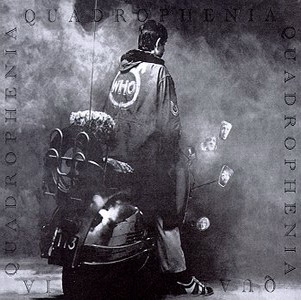
The Cover Of The Album
I consider Quadrophenia the biggest cultural contribution The Who ever made. That is a bold statement if we take into account that they also sang “My Generation” and recorded the defining album “Who’s Next“, adding new melodic resources to the world of music as a whole.
When I say that Quadrophenia was (and is) a significant cultural contribution, I take into account the fact that nobody else had taken the time to look back at the mod days and present them in such a representative light. Mod was the one and only aspect of British life in the ’60s that was not absorbed by America. Everything else was. Without Quadrophenia, that knowledge would have been somehow lost. And what was all the more remarkable was that when the album was originally issued the Who’s cohorts were adopting a lyrical posture that was to end up in total disconnection, singing about the dark side of the moon and stairways to heaven. That is, music would begin to lose its immediate link with those that bought it, and that disconnection would end a couple of years down the line in the punk revolution that placed both sides on an equal level.
Prior to Who’s Next, the band trusted Pete’s musical vision. Or at the very least, they knew that Pete was capable of making music that reflected who the band was and what the public were. When Lifehouse came down in flames Pete felt the blow and had to deal with the fact that he was not that invincible intellectually. This somehow tipped the scales on terms favorable to Roger, who was more keen on a route of professional entertainment rather than the search of spiritual harmony Pete had always championed.
Everything surrounding Quadrophenia was chaotic. It was while recording the album that the band (at Roger’s insistence) ousted managers Kit Lambert and Chris Stamp, who had been around from the beginning and despite their lax bookkeeping and devil-may-care attitude had helped them shape their sound, image and vision. Pete felt it more than anybody, and when Lambert died a few years later he commented that without Kit Lambert The Who might never had been.
The original mix caused immense and endless debates. Roger badmouthed Pete extensively over it, John would remix the album for the “Quadrophenia” movie in 1979 (notoriously emphasizing the bass guitar) and the CD remaster materialized in 1996, putting everything in as balanced a setting as possible. And at around the time of the CD reissue The Who embarked on a “Quadrophenia” tour which finally let them play the piece the way it was intended and have a good time while doing so. They were backed by a big band, and cameos came from Gary Glitter and David Gilmour among others. It seemed that anything negative that they associated with the opera was finally purged out of their systems. Because the original Quadrophenia shows were the biggest disasters in their touring career. They lacked dynamic, were a technical nightmare (Pete changed guitar over 40 times per show; Keith had to play though headphones) and basically frustrated everyone within their camp.
But as Moon’s biographer Tony Fletcher so accurately propounds, the greatest art often emerges from the most trying circumstances and contexts…
Continue to Part 2: Quadrophenia analyzed and discussed.

Pingback: 100 Posts! | MusicKO
Pingback: Quadrophenia (The Who) – Album Review (Part 2) | MusicKO
Pingback: Pete Townshend – General Introduction | MusicKO
Pingback: Paul Weller: The Unauthorised Biography (Steve Malins) – Book Review | MusicKO